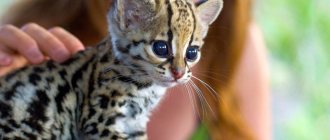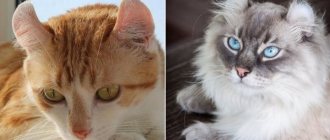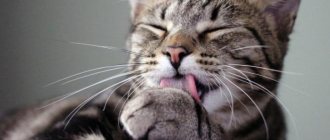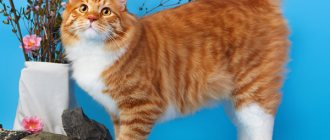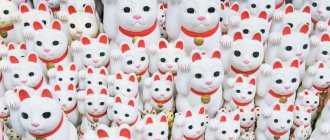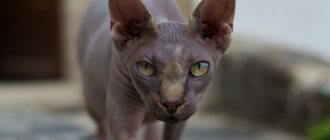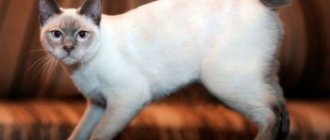The Karelian Bobtail is an unusual breed of domestic cat with short, curved tails that resemble round and soft pompoms. Karelians are perfectly adapted to survive both in the frosty climate of both the Karelian hinterland and in a city apartment. The place of origin of the breed is considered to be the expanses of Karelia and Ladoga. Many experts believe that the ancestors of the Karelian Bobtail were Norwegian forest cats.
Only at the end of the last century did the first official mention and description of the breed appear. Unfortunately, there are not many of its representatives in the world yet, but despite this, fans and owners of the Karelian Bobtail love these unusual and beautiful cats. This breed is recognized only by the World Federation of WCF.
Description of the Karelian Bobtail breed
The Karelian Bobtail is a small breed of cat, with a short tail from 4 to 13 cm. The average weight for males is 4-6 kg, for females it is 2.5-4 kg, males also exceed females in size.
- The head is narrow, has a wedge-shaped skull and large erect ears with small, barely noticeable tassels. The forehead is flat. The muzzle is without cheeks, the whisker pads are barely noticeable. The chin is small and strong.
- The eyes are medium in size, oval in shape and slightly slanted.
- Body: the back is straight, the croup is slightly raised, as the front legs are slightly shorter than the hind legs.
- The legs are slender and muscular, the paws are round and wide.
Karelian bobtails come in two types: shorthaired and longhaired (semi-longhaired). The undercoat is short and dense. The long-haired ones have “pants” growing in the area of the hind legs, and a shirtfront on the neck. But shorthairs have thicker and more beautiful hair.
The color of the animal may be the most unusual. Breeders identify several primary colors, which are mixed together into unusual combinations (bicolor, tricolor, tabby):
- Ginger;
- Grey;
- Black;
- White.
In this species, individuals of only one color are rarely found, since “camouflage” colors are common among them, for more convenient and inconspicuous hunting.
Colors
Variety is allowed (including tricolor and bicolor). Exceptions: fawn, Siamese color, blue and brown shades.
In the photo there are cats of the Karelian Bobtail breed of popular colors
When choosing a baby, be sure to look at his parents and ask to see the kitten’s passport. A small bobtail should be active, playful and not afraid of hands extended to him, with clean eyes and nose.
Character
Cats of this breed adapt well to any living conditions, although they have a freedom-loving and independent character. This is due to the fact that in nature they live in prides, where they have their own hierarchy, as well as the need to coexist with relatives.
That’s why they quickly get used to a person and value his love and affection very much, but they rarely give in to their arms. A big advantage of the character of these cats is that they do not remember insults, and therefore are perfect for families with small children.
- Karelian Bobtails retain their youthful character for a long time, and even at age they are active and playful.
- At the same time, cats are very smart and with proper training can be very obedient.
- There are no conflicts with other animals, since they do not see the need to divide the territory or mark it.
- They treat strangers calmly, without aggression.
Since bobtails have a very thick undercoat, they tolerate low temperatures and drafts well. Therefore, they can be taken for a walk at any time of the year.
Karelo-Finnish cats: history of the breed and origin
Karelian Bobtails, or Karelian-Finnish cats, are not the most popular breed among owners and breeders. Originating in the north of Karelia and in the area of Lake Ladoga, the cat was loved by local residents for its calm disposition, harmoniousness with other pets, devotion and intelligence.
Scientists believe that Norwegian forest cats played an important role in the genetic formation of the Karelian Bobtail. It is possible that the Karelian-Finnish cat inherited its hunting skills from them. In nature, such cats lived in small groups in the Karelian forests.
Tailless cats have lived in houses near humans since time immemorial. But felinologists were somehow not interested in this species.
On the initiative of breeder Liliya Dvoryaninova, a description of the breed was created, and several individuals were bred. They were first presented at an exhibition in Leningrad in 1987.
The cats did not become popular after the official introduction; felinological organizations at that time did not consider it necessary to register them as a separate breed. Only in 1994 the Karelian Bobtail was registered in the WCF.
Although, it should be noted that cats of this species have not received due recognition, and at present they are bred in very limited quantities.
Care instructions
Caring for Karelians is standard and is no different from caring for other breeds.
- Wool. They should be brushed every week, and during the shedding season from 2 to 4 times, depending on the length of the coat. Use special brushes with natural bristles or rubber combs.
- Bathing. Like all bobtail cats, they do not like to take a bath, but it is necessary several times a month. When bathing you need to use special shampoos.
- Eyes. You need to wipe your eyes every day, while moistening a cotton pad with water, tea leaves or chlorhexidine.
- Ears. You need to clean your ears once a month with a regular cotton swab or gauze.
- Claws. You can get a special scratching post for your pet, but if you don’t have one, you will need to trim it every month. This can be done using nail scissors or a nail clipper.
- Tray filler. You can choose absolutely any one, the main thing is to clean the tray on time, since bobtails are very squeamish.
What is also important is that your pet needs its own sleeping place.
This breed pays special attention to sleep, and therefore its bed should be in a certain place and preferably with a roof, so that the animal can hide and rest.
Maintenance and care
Closeness to wildlife is much more noticeable when it comes to animal sleep. Wild cats prefer to sleep 60–80% of the time of the day and if Karelana is disturbed, he will do the same. The first thing the future owner needs to get is a cozy, soft and warm lounger.
Coat care is quite simple - combing the guard hair once a week and daily combing of the down hair during seasonal molting. A massage glove is suitable for caring for a short-haired bobtail; a long-haired pet should be combed with a wide-toothed metal brush. To maintain general health, weekly examinations and hygiene procedures for the eyes and ears are required. Pets that roam freely on the street must be examined daily. Provided they have adequate nutrition and timely care, Karelians do not have problems with their teeth.
Nutrition is the main point of care. The diet of the Karelian Bobtail should be rich in proteins and balanced. It is preferable to feed natural food, 50% of which is lean meat. Dry industrial food of super-premium quality is a worthy replacement for the morning meal, however, do not forget that Karela is a hunter and if a mouse is caught, it will be eaten.
Dietary recommendations
Most animals are not picky about their diet; they can eat both natural food and feed. It is important to know here that you should never mix these types of diet!
A natural menu should include products that will meet the need for vitamins and microelements in your pet’s body. The basis of the menu should be meat, since it makes up 80% of their food in nature.
Recommended diet
- Raw or boiled meat (beef, chicken, veal, rabbit, lamb or turkey);
- Lean sea fish (hake, flounder, trout);
- Eggs: boiled chicken yolk, raw quail and goose;
- Fermented milk products (cottage cheese, kefir, yogurt, Varenets sour cream, natural yogurt, hard unsalted cheese);
- Steamed or stewed vegetables (carrots, zucchini, asparagus, broccoli, pumpkin);
- Apples, blueberries, cranberries and greens;
- Vegetable oil (sunflower, olive, flaxseed);
- Porridge (oatmeal, semolina, pearl barley, rice, buckwheat).
Prohibited diet
- Smoked meats;
- Bones (raw, cooked);
- Garlic, onion;
- Eggplants and tomatoes;
- Flour;
- Semi-finished products;
- Sweets and chocolate;
- Fatty meat and lard (pork, goose);
- Spices, marinades, sauces.
When choosing dry and wet food, you must remember that colored packaging and catchy advertising do not make the food good. Therefore, it is important to understand what your pet eats.
Diet features
Most often, owners of four-legged animals prefer dry types of food. But they are not considered the only correct ones. Such cats feel great on a natural diet. They do not go overboard with food, but they begin to act up if you pamper them.
The diet should always include lean meat in the form of rabbit, poultry, and beef. Eggs, fermented milk products, and sea fish will be beneficial. As for the daily norm, it is calculated based on the general condition of the pet, its physiological and age-related needs (lactation or pregnancy, sterilization or castration). Exceeding the permissible dosages will inevitably lead to obesity with the subsequent development of serious pathologies.
Diseases and treatment
Karelian Bobtails have good, strong health, so illnesses are rare among them, as well as a genetic predisposition to any types of diseases and pathologies.
With proper care, a pet can live up to 20 years. However, it is important to remember that timely vaccination of domestic cats can help avoid many problems.
Basic vaccinations that Karelians must receive:
- Chlamydia;
- Rabies;
- Calicivirus;
- Feline distemper;
- Rhinotracheitis;
- Infectious peritonitis.
The list of vaccinations can be expanded, it depends on the bobtail’s lifestyle.
The normal body temperature of a cat is 37-39 degrees; if it rises to 40, then you must immediately contact a specialist, since such a temperature indicates the animal is hot and is extremely critical for it.
When the first symptoms of illness appear in your pet, you must provide him with free access to fresh, not cold water and contact the nearest veterinary center.
Advantages and disadvantages
Tailless beauties are loved by many cat lovers
From the description of Karelian Bobtails we can conclude that these cats consist almost entirely of pluses only. Good health will not be a reason for constant concern about his well-being, a calm disposition does not irritate those who like silence, and their sociability and friendliness make them favorites of adults and children, as well as good friends with pets. And they are good guards, to the extent, of course, of their cat strength. And their intelligence deserves special respect. But it’s difficult to find perfect people in everything. These cats are very touchy, and they are quite difficult to acquire. Even if you can find a nursery to buy a pet, you will need to find a decent amount to purchase it.
Mating
Karelians reach sexual maturity in the first year of life. However, it is recommended to breed them when they reach 1.5 - 2 years of age, and always only with relatives, since mating with other species can end badly. It is better to conduct the meeting on the male’s property.
Before a planned pregnancy, a cat should not be bathed so as not to disturb its scent, which is so attractive to the male. After conception, it is necessary to maintain a certain diet to maintain the mother’s body.
Since the females of this species are in good health, pregnancy and childbirth are easy for them. However, at birth it is best to have a veterinarian present to assist.
They make the best mothers and never leave their babies for a moment, protecting and protecting them. If there are a large number of babies born, it is better to organize additional complementary feeding so that the little kittens’ bodies are properly formed and there are no health complications in the future.
Health of Karelians
What else bobtails can boast of is excellent health. Inherited from their wild counterparts, they received not only a shortened tail, but also resistance to various diseases and strong immunity. But sometimes illnesses still occur. Regular walks in the fresh air, which have a beneficial effect on your pet’s well-being, will help prevent frequent visits to the veterinarian. A balanced and properly organized diet is important. In such conditions, bobtails from Karelia can live 15 years or more.
Kittens
Adopting a Karelian Bobtail kitten is incredibly difficult, since this species is very rare. Therefore, the choice of a little friend must be approached with the utmost seriousness. Before purchasing, it is best to visit exhibitions and talk to breeders.
Find out all the information about parents, diseases, living conditions and nutrition. It is also recommended to examine all kittens born in the litter. All animals must be well-groomed and active.
When choosing a pet, you need to pay attention to the following criteria:
- Ears, eyes and nose without discharge;
- The skin under the fur is free of redness, rashes and wounds;
- The mucous cavities have a uniform pink color;
- The animal is not thin, the belly is round, but not bloated;
- The anus is clean and without cracks.
After purchasing the kitten, the breeder must provide the following documents:
- Passport confirming the breed;
- Veterinary card with vaccinations.
But if a breeder offers to buy a bobtail kitten with a share, it means that this is a deception, since the cat receives a pedigree only after the first independent exhibition.
The price of a Karelian bobtail baby ranges from 15 thousand rubles. — 40 thousand rubles. Such a large range depends on what the Karelian is purchased for, so if you want to acquire a champion, you will have to pay a fairly large amount for the purchase.
Where can I buy
Since the breed is not very widespread in wide circles, people often do not even know where to buy a Karelian Bobtail.
It is better to do this from trusted breeders, even if the pedigree is not very important. This way you will be 100% sure that this is the breed in front of you. In addition, nurseries will give you detailed information on how to care for your pet.
If you see an advertisement on the Internet with a photo of a Karelian Bobtail at a low price, you should not rush to purchase. Most likely these are scammers.
Interesting facts
- Cats of this breed have habits that are characteristic of dogs. They protect their territory by making rounds and checking for changes.
- Karelians have lively facial expressions and can make an upset expression on their faces if they are offended by something.
- When jumping, these cats push off with all their paws at once, not just two, as all cats do.
- Males of this species do not have a predilection for marking territory.
- Bobtails are very sensitive cats, and therefore if tension is felt at home, they try to smooth it out and cheer up their owner.
- These tailed animals choose only one owner, usually this is the person in whom they feel the leader.
- Since ancient times, settlers of the Karelian Isthmus believed that this breed brings good luck and happiness.
Purring creatures are considered mysterious, elegant, independent creatures. This is probably why women love to have them. But here, too, everything is not so simple: it is one thing to shelter a murka from the street, it is quite another to get a cat of a rare breed, care for it and spend a lot of money on your pet.
“Petrozavodsk Speaks” went to one of the city cafes, where owners of amazing and rare cat breeds gathered. Someone in our time of crisis will consider this hobby to be an excess (as they say, children in Africa are starving, and here you can afford a cat for 50 thousand rubles!), and someone will admire such a passion.
In a small room of the cafe, orange, marbled, leopard, Abyssinian, Karelian, Kuril and Mekong bobtails, their owners and the famous specialist, owner of the nursery Angelina Koltsova gathered.
The professionals give out the details. If an ordinary person washes his hands after touching a cat, then Angelina sprays the table with an antiseptic and sanitizes her hands before picking up another rare handsome man. For two hours, the cat specialist seemed to be reading a horoscope for each of the pets, talking about their character traits, habits, behavior... The owners present did not dispute what they heard, and in personal conversations they even confirmed that everything was so, everything was true.
The introduction of cats and cats began with bobtail breeds.
According to Angelina Koltsova, Kurilian bobtails belong to an independent aboriginal breed, and are not the fruit of love between a Japanese bobtail and Siberian females, as is sometimes said.
“Kuriles” are born with a short tail of three to seven centimeters. And it can be of any shape - even a spiral, even a “stump”. — With this structure of the tail, cats have an unusual body - it is short with high hind limbs. The legs are strong and muscular. If ordinary cats, before jumping somewhere up, try it on, then these comrades, due to their strong rump and legs, make a jump straight from the spot. These are the best bird catchers and mouse catchers,” says Angelina Koltsova.
Life on the island leaves its mark, so Kuril bobtails are not only not afraid of water, but are also considered excellent fishermen. During spawning, fathers and their young go after the prey: the fathers throw the fish ashore with a strong blow of their paw, and the kittens are already dragging it away from the water.
These cats get along well with their relatives. Housewives take note: they do not mark territory, but they can scratch furniture. A high-placed scratch mark is a way to indicate your presence. Well, if you suddenly have a dog lover in your house, then this cat can easily replace the dog, because Kurilian Bobtails are not the type to lie with you in front of the TV. You will have to walk with him, and for a long time.
— These cats are considered the smartest. They clearly know 30 to 35 words. When you mention 70-80, they can understand what we are talking about. So it’s always easy to come to an agreement with them,” noted Angelina Koltsova.
And here is the Mekong bobtail Gesha. Don't be confused by the geographical reference to the East in the name, this is a Russian native breed. It was in our country that they noticed and began to breed such animals. So, according to registration, the Mekongs are our fellow countrymen. But registration, unfortunately, does not add points to them in the cat market. Breeders admit that this breed does not sell well, simply because people do not understand the special beauty of these animals.
“These cats have reached the world championships, but they don’t have any outstanding victories yet,” admits Angelina. By the way, felines are serious in this regard: to become a world champion, you need to get titles on three continents.
So calculate how much it will cost the owners, and at the same time estimate how much they will then ask for the kittens born from the champion. This is the pricing, but we will talk about this a little lower.
The best thing about the Mekong breed is their blue eyes. Mekongs also love to walk, but the company of their owner is important to them. According to the expert, these cats are ready to do anything with their owner, even peel potatoes, and not every family member is capable of this, you must admit. In the face of these cats you will get a companion for many years - their life expectancy is about 20-25 years.
“During this time, they do not become decrepit, do not grow old, and do not break out. They are in normal muscular shape, if, of course, you monitor their nutrition. The breed loves to walk on the owner's shoulder, so for a well-fed cat you will have to pump up your muscles.
Vanka was given to the owners by friends.
What kind of breed this was, what it was called, they had no idea, but they fell in love with the cat: “I have two friends and both are Vanka, so let the third one now live at my house,” explained the owner of the rare breed. They just came to the meeting with their mother to find out who it was. Expert Angelina Koltsova immediately recognized the ashy Vanka as a Karelian bobtail . Such cats, judging by the expert’s words, are very difficult to find, so this cat has a long exhibition career ahead of him, if the owners don’t mind. Angelina expressed her readiness to even take it to exhibitions at her own expense in order to show her colleagues a rare specimen.
As for the owners, the young man admitted that since childhood he adores these fluffy and meowing animals, and such a neighbor was only welcome in his bachelor apartment. This is the sixth cat in his life.
— I also love dogs, but working dogs. My father was a game manager, and we had huskies all our lives. I have a special love for this breed. The dog must be hard-working, guard the yard, and go hunting. And a cat is part of the family, part of the owner.
The cat Vanyok, according to the owner, is very smart and tactful: for example, in the village he goes outside on his own, jumping on the door handle to open it.
And at home, Vanyok accompanies his owner everywhere: the cat’s favorite pose while watching TV is “relaxed man.” We believe that everyone can draw this picture in their head.
Cute bobtail cats have been replaced by exotic breeds. These animals are definitely not like our Murkas and Snezhki, and it would be hard to call them that. The leopard color, thin graceful body, and sometimes a completely un-cat-like voice create, in a sense, an atmosphere of mystery around these cats, who never know what’s on their minds.
Their cost is also quite high. Manufacturers are usually brought to Petrozavodsk from Moscow or from abroad, so prices range from 1-1.5 thousand euros.
It is clear that the number of people wishing to have such a pet at home decreases sharply after this. Sometimes you have to sell kittens not even at cost, but to your own detriment,” admitted breeder Angelina Koltsova. Nursery owners can invest up to 300 thousand in one animal: this includes food, veterinary care, and frequent trips to international exhibitions.
- This is an expensive hobby. Yes, we are sick,” Angelina jokes and compares her hobby to collecting also incredibly expensive model cars. It is almost impossible to make money on purebred cats and cats, and the question from exhibition participants is “How much will you pay us for participation?” causes sad laughter among club owners and organizers.
— Imagine how much love was invested in these animals, how much effort was spent caring for them, how much knowledge! We don’t leave the doctors, we constantly get vaccinations, ultrasounds, all kinds of tests...
— It’s a big breakthrough that we now have a 24-hour veterinary hospital. Something often happens to animals at night, and everyone called us and asked for help. We took a taxi with syringes, now we can turn to professionals.
True, the price tag for veterinary services is such that several people can be cured. For one procedure you need to pay an average of 1-2 thousand rubles, and not everyone can afford this,” the expert complained.
Sometimes veterinarians have to work overtime to save a dying animal.
The Abyssinian cat is one of the oldest breeds in the world.
The title requires an appropriate attitude towards one’s roots. At the meeting they talked about the Finnish “Abyssinians”, whose pedigree dates back more than a hundred years. - Of course, these cats were carefully looked after. During World War II, so that nothing would happen to the animals, they were taken to America, where the nursery lived for ten years. After this, the owners and the cats returned to England, and from there they moved to Suomi. Thanks to such enthusiasts, we have preserved absolute values today,” said Angelina Koltsova.
In the picture in front of you is the cat Rita. Despite the almost noble aura, the cat turned out to be very sociable: she walked into people’s arms, offered to stroke herself and, without hesitation, admire such beauty.
Rita is a Sorrel colored Abyssinian cat. Within the breed there are also “wild” ones interspersed with black pigment, blue ones and fauns (pink-sand color).
Even an allergy sufferer can have such an animal in the house, because Abyssinians have no undercoat.
They love to look at the world from top to bottom, carefully climbing onto cabinets, doors and other high places in the apartment.
“No matter how many figurines and photo frames you have on your shelves, this cat will go around everything very carefully.” For her to knock over or break something is a rare occurrence. If this happens, she herself will be the most upset,” the expert assured those present. The ideal domestic cat.
And this is
marbled
Bengal cat The breed was formed by California resident Jen Mitch, which took her about 40 years. While on a trip to Asia, she noticed two wild leopard seals. In the East, fur coats were made from adult individuals, and babies were sold as souvenirs. The American woman brought this kitten home and began working on breeding. The difficulty was that wild animals cannot mate with domestic ones.
It's like trying to get offspring from the love of a ferret and a dog. Nevertheless, in some incredible way, the Asian leopard mated the Himalayan cat.
From this union a sterile boy and a healthy girl were born, of unusual color and capable of procreation. So, over time, the breeding work of Jen Mitch led to the emergence of a breed of cats with a unique coat, which has a unique sheen and shine, which is called glitter.
- Don't forget that these cats have recently emerged from the wild, so they can sometimes be shy or aggressive. Especially when it comes to food.
This breed has a special temperament; they are not for calm people,” Angelina noted.
At the meeting I managed to meet two Bengal girls. If the first one had a non-standard color, then its relative is a classic with an exact leopard print.
You will have to pay a lot for such a restless beauty. The price starts from 70 thousand rubles, but in Petrozavodsk kittens can be found for 15 thousand.
The St. Petersburg Sphynx was bred and patented by one of the most authoritative Russian felinologists, Olga Mironova.
The author's breed with ears like a bat was born from the love of an eastern (oriental) cat and the Don Sphynx. After some thought, experts decided to breed such animals, assigning to them the characteristics of Siamese and Orientals, but without hair.
At the moment, the breed has not yet been established, so such cats do not always go naked.
The specimen in front of you turned out to be straight-haired, which does not meet the standards, however, you must admit, you don’t want to call such a pug the rude word “culling.”
— Those who love jazz can get such cats. “They have low voices,” the specialist advised.
But, perhaps, this cat “spoke” in the most amazing voice.
They called her nothing less than “the most characteristic in this city,” although the hostess assured that this was not so. The appearance of the Cornish Rex is, to put it mildly, unusual and even alien.
And Angelina Koltsova’s words that the breed appeared as a result of a spontaneous mutation only added to the associations with Frankenstein. Of course, Lolita is not a monstrous giant at all, but her color was reminiscent of bats, which not everyone likes.
— In England, curly-haired cats appeared almost simultaneously in Devonshire and Cornwall. They are completely different in type and genetics, but both breeds have a fine, crimped coat with no undercoat. This is the only cat breed that is recognized by experts as hypoallergenic.
Lolita was born not in Cornwall, but in Petrozavodsk at the Poultry Farm.
According to the owner, she does not meow, but sings or howls. Lolita is one year old and lives outside the city with three other cats, the eldest of which is already 20 years old. The owner plans to have offspring from her Cornish Rex. As we were told at the meeting, there is already a 90% probability that Lolita is pregnant. The cost of such a cat starts from 10-15 thousand if you just want a pet, and from 20 thousand for subsequent breeding.
Everyone knows that cats are not simple animals, self-sufficient and with character. Probably, in rare breeds all these qualities manifest themselves in an even more pointed form. Genetics takes its toll.
Photo by the author and Andrey Basov

